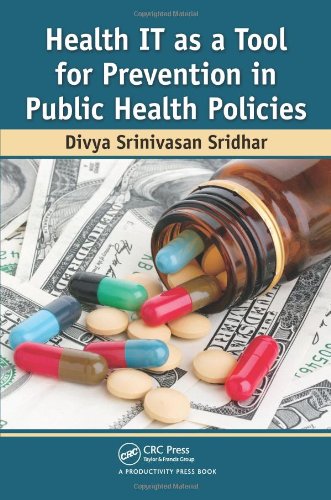Health IT as a Tool for Prevention in Public Health Policies 1st Edition by Divya Srinivasan Sridhar ISBN 1040082653 9781040082652
$50.00 Original price was: $50.00.$25.00Current price is: $25.00.
Health IT as a Tool for Prevention in Public Health Policies 1st Edition by Divya Srinivasan Sridhar – Ebook PDF Instant Download/Delivery: 1040082653, 9781040082652
Full download Health IT as a Tool for Prevention in Public Health Policies 1st Edition after payment
Product details:
ISBN 10: 1040082653
ISBN 13: 9781040082652
Author: Divya Srinivasan Sridhar
Health IT as a Tool for Prevention in Public Health Policies examines the current state of Health Information Technology (HIT) in the United States. It investigates the converging problems of chronic disease, societal welfare, childhood obesity, and the lack of healthcare for the economically disadvantaged in the U.S. It considers various providers.
Health IT as a Tool for Prevention in Public Health Policies 1st Table of contents:
1 Theoretical Underpinnings: Comparing the PPACA and HITECH Acts
Introduction
Theoretical Perspectives
Social Cognitive Theory
Measuring Progress and Outcomes
Conclusion
References
Section II Government and Technology Policies
2 Impact of E-Government on Electronic Health Literacy
Introduction
Theory
Sources of E-Health Initiatives by E-Government
Mobile Health Initiatives
Initiatives to Reduce the Digital Divide
Legislation Impacting E-Health Literacy
Key Legislation for Furthering E-Health
Health Insurance Exchanges
RHIOs
Web Design and E-Health
Non-Health-Related Legislation Furthering E-Health
Policy Analysis: Summary of Importance of E-Government on E-Health Literacy
Trust in Information Sources and Impacts on E-Health Literacy Outcomes
Methods
New Contribution to the Field: New E-Government Term
Interpretation and Results
Policy Recommendations and Conclusions
References
3 Financial, Social, and Environmental Impact of Government HIT Adoption Policies
Assessment of the Barriers to Health Information Technology (HIT) Adoption across Organizations and the U.S. Policy Solutions
Organizational Variation in EMR Adoption
Barriers to EMR Adoption
Economic Costs of EMR Adoption
Economic Policy Strategies to Help Organizations with Slow Rates of Adoption
Social Barriers to Technology Adoption
Social Policies to Help Organizations That Are Unable to Adopt EMRs
Environmental Barriers to Technology Adoption
Environmental Policy Strategies to Help Organizations with Slow Rates of Adoption
Conclusion
References
Section III Individualized Technological Prevention Strategies for Chronic Conditions
4 Self-Management Technologies and Type 2 Diabetes
The Effects of Self-Management Technologies on Type 2 Diabetes Patients
Purpose
Introduction and Background
Policy Relevance
Theoretical Backing
Methods
Results
Web-Based Technologies
Mobile and Telephone Interventions
Video Games
Discussion
Conclusion
Limitation of the Chapter and Possible Sources of Bias
References
5 Individualized Prevention Solutions to Childhood Obesity
Underlying Causes and Consequences of Childhood Obesity
Consequences of Childhood Obesity
National Policy Solutions
State Policy Solutions
Local Policy Solutions
Environmental Policies
Physicians and Health Providers
Media Impacts
Economic Policies
Political Community Relationships/Partnerships
Child Care Policies
Technological Policies and Social Media
Political Impacts
Conclusion
References
Suggested Readings
Section IV National and International Impacts of Hit on The Community
6 Health Information Technology in Community Health Centers
The Formation of Community Health Centers (CHCs)
Theory for the Design
Literature Review
Research Design
Research Experiment 1: Randomized Experimental Design
Research Experiment 2: The Survey Design
Conclusion
References
7 Small-Practice Physicians and HIT
Why HIT? What Is It and How Can It Help Small-Practice Physicians?
Physicians and Organizational Leadership
Literature and Theories Relating to Technology Diffusion
Technology Diffusion
Customer Service and Quality
Barriers to Adoption
Looking to the Future: New Research
How Do Small Practices Deal with Change and Regulation?
Methods
Hypotheses
Survey Findings
Vendors
Government Impacts on EMR Usage
Routine Rigidity
Results and Analysis
Conclusion and Recommendations
References
8 The Micro, Meso, and Macro Perspectives of HIT Adoption
Introduction
Macro-Level Policies and Considerations
Meso-Level Challenges to Electronic Medical Record (EMR) Adoption
Micro-Level Challenges to EMR Adoption
Conclusion
References
9 Geographic Disparities in Healthcare
Geographic Disparities in Health Resources
Geographic Disparities in Healthcare Professionals
Policy Solutions to Geographic Maldistribution of Resources and Care
Solutions to the Shortage of Health Resources and Services: Federally Qualified Health Centers (FQHCs) and Community Health Centers (CHCs)
Solutions to the Shortage of Health Resources and Services: Telemedicine Resources
Solutions to the Shortage of Health Resources and Services: Concierge Medicine
Conclusion
References
10 International Comparisons: Differences in U.K. and U.S. Preventive Health
Applying the Reforms of the U.K. NHS to the U.S. Health System: A Comparative Perspective
Introduction
General Differences: The U.K. versus the U.S. Health System
Reforms to the U.K. Health System in the Early 2000s
The U.K.’s QOF System
Criticisms of the U.K. Health Reforms and the QOF
Comparing and Applying the U.K. to the U.S. Health System
Comparisons and Additions of the U.K. QOF to Concierge Medicine
Conclusion
References
11 Conclusion
Putting It All Together
People also search for Health IT as a Tool for Prevention in Public Health Policies 1st:
Tags:
Divya Srinivasan Sridhar,Health IT,Tool,Prevention,Public Health Policies
You may also like…
Medicine
India’s Public Health Care Delivery: Policies for Universal Health Care 1st Edition Sanjeev Kelkar
Medicine
Food law for public health 1st Edition by Jennifer L Pomeranz ISBN 9780190227258 0190227257
Relationships & Lifestyle - Diet & Nutrition
Biology and other natural sciences - Ecology













